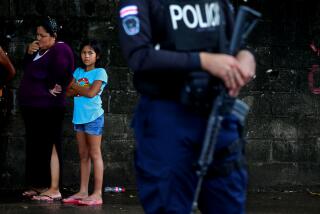2 Mass Graves in Iraq Unearthed
Two recently excavated mass graves containing the bodies of at least 38 people allegedly killed by Saddam Hussein’s regime after a 1991 Shiite uprising in southern Iraq will probably provide key evidence for a third war crimes trial against the deposed Iraqi president.
Skeletal remains were unceremoniously tangled together amid the dirt. Blindfolds and wrist ligatures were found on many of the remains. Some skulls contained jagged bullet holes, evidence, according to forensic examiners, that the killers shot their victims from the rim of the grave.
The victims were mostly men aged 20 to 35, according to forensic archeologist Michael “Sonny” Trimble, head of the main Iraq Mass Graves Team, an international group of about 15 workers. Most of the corpses lacked shoes, investigators said, a sign that they were hastily rounded up and transported to the site.
“They wanted to dispose of people and kill them very quickly,” said Trimble, of St. Louis. “These people did what all mass murderers do; they dig deep, they kill someone quickly, cover them up and then leave.”
Evidence at the site is expected to be used in a yet-to-be scheduled trial. Hussein is currently on trial for his alleged involvement in the killing of 148 Shiite residents of Dujayl. He is then due to be tried for the 1988 Anfal campaign involving the use of chemical weapons against Kurds in northern Iraq.
The trip to the southern gravesite was arranged by U.S. and Iraqi officials investigating the slayings of an estimated 100,000 to 180,000 victims of a government crackdown on a Shiite uprising. That rebellion in 1991 followed the withdrawal of U.S. and coalition troops after the Persian Gulf War.
Details of the trip were provided to news agencies by pool reporters from the New York Times and Agence-France Press.
Investigators plan to try at least 70 defendants in the case and have already questioned Hussein in the course of the probe. Forensic workers began excavation of the bodies three weeks ago.
The site is a former artillery range about an hour’s drive from a major southern city. Investigators asked journalists not to publish the specific location because of safety concerns and fears that insurgents could try to damage evidence.
U.S. satellite imagery has revealed 200 possible gravesites in Iraq -- a legacy of Hussein’s brutal regime. Investigators narrowed that list to 18 burial grounds.
The site Saturday was a barren, pockmarked landscape where temperatures climb well above 100 degrees. The area is 4 1/2 miles from a road stretching toward Iraq’s southwestern border.
A team of about 120 forensic workers has set up a camp and marked bones, bone fragments, spent ammunition and skulls with blue, red and yellow flags. Investigators said they have found more than 80 empty AK-47 cartridges among the bodies. The larger of the two mass graves is about 10 feet by 35 feet long and declines from ground level to about 5 feet at its deeper end.
Once disinterred, the bodies will join the remains of about 300 victims of other mass killings in refrigerated evidence containers at Baghdad’s international airport for pending trials.
Forensic workers said that the killers prepared the larger grave with an excavator.
“We know these people were loaded onto buses and trucks and taken somewhere, and that the vehicles then returned empty,” said Investigative Judge Raid Juhi of the Iraqi High Tribunal. He said the tribunal had discovered documents that proved the killers “were given powers that authorized these killings” without any formal judicial procedures.
More to Read
Start your day right
Sign up for Essential California for news, features and recommendations from the L.A. Times and beyond in your inbox six days a week.
You may occasionally receive promotional content from the Los Angeles Times.






